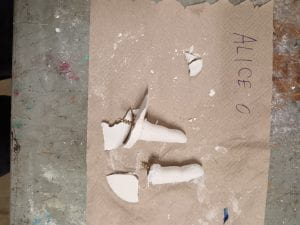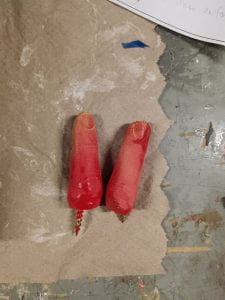We began this homework assignment in class, first mixing the alginate in a pot, sticking a finger into it and waiting the required 5 minutes to let it set. Then very carefully, I removed my finger from the alginate. This step went smoothly and a mould of my finger was created. Then we mixed and poured plaster-of-Paris into the moulds. However my ratio for this must have not been quite right since when I returned to the OEDK later that evening, the plaster had not set and there was a thin layer of water over the top.
So I redid the steps from class and corrected the plaster -of-Paris ratio to give two 3d castings of my finger. Once the plaster had set, then came the tricky bit. De-moulding the fingers was a little nerve racking since I had to ensure I could take the fingers out of the alginate mould without cracking the plaster. Ultimately this was successful and I had two 3d finger castings with screws embedded.

Then I had to break off the excess plaster from the base of the finger – again without damaging the main cast. I used a utility knife to remove the excess plaster a little bit at a time, scoring a line then using the point of the knife to break along the scored line. This worked very well to take the plaster off in small sections. Then I was able to use sand paper to remove any remaining lumps and bumps from the surface of the finger, and clean up the edges. I first used a coarser 180 grit sandpaper for the base then a fine 400 grit for finer details and finishing.
The next step was painting the fingers. The first spray paint colour I chose thinking it was a gold hue but when I sprayed it, it turned out to be a peach colour that was eerily close to my own skin tone. I decided that this was too realistic so decided to recoat in red spray paint since this would be opaque enough to cover the existing paint. However after partial spray, I found the result amusing since the fingers looked like Halloween severed finger props. This decision however means that the fingers are no longer identical since the red spray paint was just partial coverage.
So I left the fingers as they were and coated with a glossy, clear top coat. I would have liked to use matte but there was none left and when the gloss went on, it made the red shiny and more realistic so I am happy with the end result.


Cost Breakdown:
- Materials
- Alginate: ~2oz = $0.59
- $8.28 for 28oz (https://tinyurl.com/Alginate1234)
- Plaster of Paris: ~4oz = $0.50
- $7.99 for 4lb (https://tinyurl.com/MichaelsPoP)
- Water: Free
- Alginate: ~2oz = $0.59
- Equipment: Free with OEDK access
- Mixing Pots
- Popsicle Stick
- Scales
- Masking Tape
- Labour
- 3 hours total @ $15 per hour
- $45
- Total cost = $46.09
